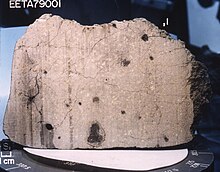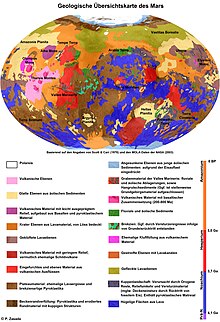Martian rocks
Mars rock is a collective name for the rocks on the planet Mars . According to the position of Mars within the solar system - in the zone of the terrestrial planets - on its surface, as well as on Mercury , Venus , Earth and the Earth's moon , mainly silicate rocks can be expected. As on Earth, these can be of volcanic-plutonic origin, metamorphic or sedimentary .
The most widespread are basalts rising from the mantle and some deep rocks rich in quartz such as andesite , as well as olivine and various conglomerates . Part of the surface of Mars is covered by the regolith, similar to moondust .
Knowledge

Scientists have known direct rock samples from Mars in the form of some Martian meteorites for a long time . A number of meteorites have been discovered on Earth , the chemical composition of which indicated that they came from Mars. Small gas inclusions were found in it and isotope ratios could be determined, as measured by space probes in the Martian atmosphere.
Further analyzes of Martian rocks were carried out by some Martian missions in which rocks directly on the Martian surface were examined with robots from landing devices. The first such results were achieved in 1997 by the Mars Pathfinder analyzer designed by US planetologist Matt Golombek . Sampling with a return to earth should, however, be possible in a few years at the earliest (see also the planned Mars Sample Return mission ).
Some indirect methods provide information about the rocks of Mars, including optical observation using high-resolution images of the Mars surface, which allow conclusions to be drawn about the geological processes on Mars and thus also about the rocks that may be formed. Further information is obtained from spectrometric studies that can provide information about the composition of the surface.
Volcanic rocks
Volcanic rocks occur mainly in the huge shield volcanoes of the Tharsis region and its surroundings on the western hemisphere and the Elysium region on the eastern hemisphere of Mars. The northern lowland regions may consist of hydrated and transformed basalts or andesites . In the southern highlands, the results of the spectroscopic investigations suggest the occurrence of olivine and pyroxene , which originate from volcanic rocks.
Furthermore, it can be assumed that in view of the earlier volcanic activity covered by volcanoes, stratified tuffites should also occur, which are deposits of volcanic ash and rock rain ( pyroclastics ).
Metamorphic rocks
The existence of metamorphic rocks on Mars has not yet been completely proven. What is certain is that the impacts of meteorites to a Impaktmetamorphose led. The existence of contact metamorphic rocks can be assumed at least locally due to the igneous processes. Direct evidence of regional metamorphosis as a result of mountain formation and similar processes is not yet known. Analyzes of Mars rocks by the Mars Pathfinder mission could not clearly demonstrate the processes to which the analyzed rocks Barnacle Bill and Yogi go back, a metamorphic origin cannot be ruled out.
Sedimentary rocks
On the entire planet there are significant masses of regolith , some of which can be regarded as metamorphic rocks, and represent a mixture of crushed and partially melted rocks, such as those formed when larger meteorites hit. Most of the Mars regolith, however, was created through chemical and physical weathering and consists of a mixture of dust and ice.
Aeolian sediments are predominant , which are formed by the blowing away of sand and dust masses due to the violent atmospheric movements and their deposition that are common on Mars. Extensive dune fields can already be seen from the orbit . The composition of the sedimentary rocks corresponds to that of evaporites , sulfates such as kieserite are assumed to be minerals, and gypsum seems to play a major role. The red color of the soil, which is also the color of Mars, is attributed to the existence of finely divided hematite .
Formations through the influence of water
In addition, surface shapes can be seen in many regions of Mars, which are attributed to the effects of flowing water. A possible cause would also be the effects of cryoclastic currents, which could result from the sudden release of pressure in a mixture of dry ice and clathrates .
Since the investigations of the NASA rover probe Opportunity (landing in 2004 in the Meridiani Planum), sedimentites have been known that may have formed in open surface water. Both clastic layers with ripple marks (similar to earthly sand or siltstones ) as well as chemical sediments ( sulfates ) possibly precipitated from the water occur. Particularly noteworthy are the spherical hematite concretions ( blueberries ) that are no more than a centimeter in size and that only arise on earth under the action of water and possibly with the participation of biological processes (bacteria). The interpretation of the opportunity results is controversial among scientists.
Methane sources
It has long been a mystery where the methane detectable in the Martian atmosphere comes from. Around 2–3 million tons would have to come from geological “methane sources”, for which active volcanism , earlier comet impacts or methane-producing microorganisms can be considered.
A geothermal reaction such as serpentinization would also be possible . Elements involved in this are water, carbon dioxide and the mineral olivine , which is common on Mars.
See also
Web links
- Matthias Böhm: The Geology of Mars (presentation), www.uni-bonn.de, January 30, 2002
- University of Stuttgart : Mars structure, atmosphere and climate, mineralogy (pdf, 20 MB)
